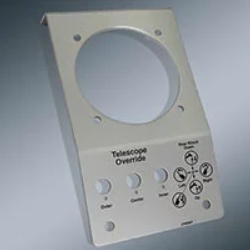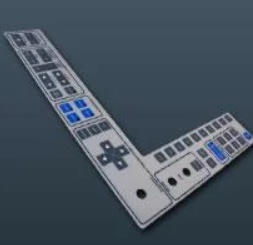Custom graphic overlays are an important component of equipment and machinery control panels, providing essential visual cues for operating the equipment or conveying other necessary information through text and graphics. These human-machine interfaces are used for a variety of applications, such as heavy machinery, aerospace instruments, maritime boat switches panels, and more.
Graphic overlays are necessary for the safe operation of equipment and machinery, so ensuring that the visual elements remain clearly visible throughout the lifespan of the asset is crucial. Overlays are commonplace but vary in size, shape, and material, so which one would best meet your business needs? Each overlay consists of a base, a printed surface, and an adhesive, all of which come in different shapes, sizes, and materials. This guide outlines the design and material selection considerations for first time buyers.
Several materials are used for graphic overlays, and each performs well in select use cases. Typically, substrate components are available in a variety of forms and thicknesses based on the level of panel flexibility and durability required.

Product shelf life is a key consideration. Any graphic overlay choice needs to last at least as long as the expected lifespan of the product — at a minimum, this will be years, but it’s often decades. Graphic overlays with fading or obscured graphics make it difficult for users to operate equipment, which is not only inefficient but also a safety risk in many situations.

Also, each graphic overlay is unique. The layout needs to fit perfectly with the final product design, and equipment may also contain unique surface contours that require custom overlay designs. For example, die-cutting can often be used to create unique graphic overlay shapes that will fit in even the most unique shapes and sizes, so the two need to be created collaboratively.
As the name suggests, backlighting refers to the illumination that comes from the back of the overlay. Since most materials used for graphic overlays aren’t entirely opaque, light can pass through them. Backlighting not only improves the aesthetics and appeal of the overlay but also helps to make the graphics more readable. Backlighting can also be used to provide helpful information, such as lighting that shows behind currently activated settings. When installing backlighting on graphic overlays, companies have several options: Light-Emitting Diode (LED), Light Guide Film (LGF), and acrylic.
Resistance centers on how well the overlay guards against different types of friction and local elements. For example, a graphic overlay should be able to withstand abrasion, vibration, impact, moisture, exposure to UV, and chemicals and solvents. This is a key consideration to ensure that the overlay stays safe in harsh operating environments.
Certain printing firms coat their graphic overlays with all sorts of finishes. A finish allows for a more appealing product but may also serve as a protective layer. Some of the most common finishes on graphic overlays include gloss, textured, patterned, matte, and resin. Choosing the right final finish, such as gloss or matte, can add an aesthetic appeal to your final design.
A graphic overlay serves both a practical and a decorative purpose. Given their critical role in the safe and effective operation of machinery and equipment, it’s important to select the right materials and design elements. However, finding the most effective solution for an application can be challenging. Consequently, companies may want to consult with their production partner, review the different fabrication options, and choose the one that best serves their needs. Get in touch with MPC today or request an evaluation kit to learn how our experts can assist you with the design process from end to end.
Our sales engineers are experts in automatic asset tracking, tagging and identification,a nd can answer all your questions. Get in touch now.
Lets Talk ›